You are using an out of date browser. It may not display this or other websites correctly.
You should upgrade or use an alternative browser.
You should upgrade or use an alternative browser.
PC Gaming Victoria 3 Announced
- Thread starter Navarro
- Start date
More options
Who Replied?Navarro
Well-known member
Victoria 3 - Dev Diary #0
Hello everyone! Yes, you’re seeing this right. No, this isn’t a belated April Fools joke. After all these years, and all these memes, Victoria 3 really is confirmed at last. I’m Martin “Wiz” Anward, the Game Director of Victoria 3, and it’s my...
 forum.paradoxplaza.com
forum.paradoxplaza.com
Hello everyone!
Yes, you’re seeing this right. No, this isn’t a belated April Fools joke. After all these years, and all these memes, Victoria 3 really is confirmed at last. I’m Martin “Wiz” Anward, the Game Director of Victoria 3, and it’s my absolute pleasure to finally be able to reveal what I have been working on since 2018 (around the time I stepped down as Game Director of Stellaris).
So what, then, is Victoria 3? I can start by telling you that it’s most definitely a proper Victoria game – namely a game with a core focus on Economy, Politics and Internal Country Management and with the iconic Victoria pop system not just included as a core mechanic but made even deeper than in either of its predecessors.
Though Victoria 3 is its own game and not an iteration on Victoria 2, our ambition is to create a worthy successor that stays true to the core values of the Victoria series while using what have learned over the last decade in terms of making games more accessible – so that we can use that accessibility to build an even deeper game for old and new players alike!
Our vision for Victoria 3 is to create what we call a ‘Society Sim’ – a game that is first and foremost about the internal workings of the 19th-century country that you are playing and how its society is shaped over the course of the game. Politics, Economy and Diplomacy are the three most important parts of the game – Wars are of course a part of the game (just as they were a part of the Victorian age), but Victoria 3 is *not* a wargame or a game about map painting.

Oh, and before you start speculating crazily about what is and is not in the game: No, there is no mana!
Now, there is going to be a lot of dev diaries going forward to dig into the mechanics of the game, but to wrap up this dev diary I want to briefly touch on the four game design pillars that we have been following when designing and building Victoria 3:
That’s all for this week, but we’ll see you next week, when we’ll be talking about the return of the Victoria Pop System and the introduction of Dependents.
- National Gardening: Building, shaping, tweaking and evolving your nation is the first and foremost focus of the game. Events outside your country’s borders can naturally affect your country in significant ways, but the game should never rely on war to provide the main source of enjoyment.
- Diplomatic Eminence: War is a continuation of diplomacy, and everything that is achievable by war should also be achievable through diplomacy (even if that diplomacy sometimes comes at the point of a gun).
- Everything is Political: Politics is at the heart of Victoria 3, and all major features should in some way tie back into the Pops and Interest Groups that form the core of the game’s politics.
- Era of Change: The Victorian era was a time of immense change politically, technologically, culturally, militarily and socially, and these changes should be reflected in the experience of playing a campaign of Victoria 3.
Navarro
Well-known member
Victoria 3 - Dev Diary #1 - Pops
Hello everyone! I’m Mikael, Victoria 3’s lead game designer - and oh boy does it feel good to finally be able to say that out loud! Today I have the pleasure to reveal some details about that one feature everyone thinks about when they hear...
Hello everyone! I’m Mikael, Victoria 3’s lead game designer - and oh boy does it feel good to finally be able to say that out loud! Today I have the pleasure to reveal some details about that one feature everyone thinks about when they hear “Victoria” - the Pops.
Pops were introduced in the very first Victoria game to represent your country’s population. Pop mechanics have since snuck into other Paradox titles like Stellaris and Imperator. But this in-depth population simulation is what Victoria is about, and we’re going to bring you a system with more depth than ever before!
In Victoria 3, Pops are the country’s engine - they work the industries, they pay the taxes, they operate the government institutions, and they fight the wars. They’re born, they die, they change occupation, they migrate. And they organize, get angry, and start revolutions.
Every Pop is visualized so you can see which demographic sports the best moustache. Note that Pop portraits are very much a work in progress!
You, the player, might be in charge of the country, but you’re not in charge of the Pops and can’t manipulate them directly. Yet everything you do to the country affects them, and they in turn will react in what they perceive to be their own best interests. A large part of your game will consist of trying to sate your population’s appetites for material goods or political reform. But most actions you will take aren’t to the benefit of every Pop in your nation, and by making life better for one part of the population you may inadvertently upset another demographic.
The most important aspect of Pops are their Professions, which reflects the types of jobs it carries out in the building where they work. A Pop’s profession determines its social class and can affect its wages, political strength, what other professions it might qualify for, and particularly which political Interest Groups it’s prone to supporting (which you will hear lots more about in future Dev Diaries.) Some of the Pop professions you will encounter in Victoria 3 are Aristocrats, Capitalists, Bureaucrats, Officers, Shopkeepers, Machinists, Laborers, and Peasants. Investing in industries that provide job opportunities for the kinds of professions you want to encourage in your country is key to the “society building” gameplay of Victoria 3.
Every variation of Profession, Culture, Religion, and Workplace in the world gets its own unique Pop. At any given time this results in many tens of thousands of Pops in the world working, migrating, procreating, and agitating.
The people that make up a Pop are distinguished into Workforce and Dependents. Members of the Workforce keep the buildings in the game operational and collect a wage from them in return. Those who cannot or aren’t permitted to be officially employed are considered Dependents. They collect only a small income from odd jobs and government programs.
Laws affect who is included in each category. At game start most countries do not accept women working and collecting a wage outside the home but by reforming laws governing the rights of women more Dependent Pops will enter the Workforce over time. By abolishing child labor, the amount of income Dependents bring home will decrease but will make it easier to educate your populace, increasing their overall Literacy. After a bloody war many Dependents of soldiers may be left without sufficient income, and you may decide to institute pensions to help your population recover.
In short: nothing in your country runs without Pops, and everything about your country affects those Pops, who in turn provide new opportunities and challenges during your tumultuous journey through the Victorian era and beyond.
I have oh so much more to say, but that is all for this week! You will hear much more from me in future Dev Diaries. Next week Martin will return to explain something quite central to the game - Capacities!
Navarro
Well-known member
Victoria 3 - Dev Diary #2 - Capacities
Hello and welcome back to another Victoria 3 dev diary! Today we will be talking about three of the four of the main ‘currencies’ of the game - namely Capacities (the last being Money, which we’ll of course come back to later). We mentioned in...
Hello and welcome back to another Victoria 3 dev diary! Today we will be talking about three of the four of the main ‘currencies’ of the game - namely Capacities (the last being Money, which we’ll of course come back to later).
We mentioned in the very first dev diary that there is no ‘mana’ in Victoria 3, and since this dev diary is about the game’s “currencies”, I want to be clear on what I mean by that. When we say there is “no mana” we mean that the resources in Victoria 3 arise and are spent in clearly defined ways that are parts of the simulation, not from an overly abstract concept or vague idea. There is, of course, some degree of abstraction involved (all games are abstractions after all), but we want all the game’s currencies to be strongly rooted in the mechanics and not feel arbitrary.
But enough about that and onto Capacities. What exactly are they?
Well, for starters, calling them currencies is actually not accurate. Capacities are not a pooled resource and are not accumulated or spent, but instead, have a constant generation and a constant usage (similar to for example Administrative Capacity in Stellaris), and you generally want to keep your usage from exceeding your generation. Each capacity represents one specific area of your nation’s ability to govern and is used solely for matters relating to that area.
As mentioned, Capacities are not accumulated, so excess generation is not pooled, but instead there is an effect for each Capacity which is positive if generation exceeds usage and quite negative if usage exceeds generation - a country that incorporates territories left and right without expanding its bureaucratic corps may quickly find itself mired in debt as tax collection collapses under the strain!
Bureaucracy represents a nation’s ability to govern, invest in and collect taxes from its incorporated territory. It is produced by the Government Administration building, where many of a nation’s Bureaucrats will be employed. All of a nation’s Incorporated States use a base amount of Bureaucracy which increases with the size of their population, and further increased by each Institution (such as Education or Police - more on those later!) that a country has invested in. Overall, the purpose of Bureaucracy is to ensure that there is a cost to ruling over, taxing and providing for your population - administrating China should not be cheap!

The Swedish Bureaucracy is currently a bit overworked and the country could certainly benefit from another Government Administration building or two.
Authority represents the Head of State’s personal power and ability to enact change in the country through decree. It is generated from your Laws - generally, the more repressive and authoritarian the country, the more Authority it will generate - and is used by a variety of actions such as enacting decrees in specific states, interacting with Interest Groups and promoting or banning certain types of Goods. Overall, the purpose of Authority is to create an interesting trade-off between more and less authoritarian societies - by shifting the distribution of power away from the Pops into the hands of the ruler, your ability to rule by decree is increased, and vice versa.

The Swedish King has more Authority at his disposal than he is currently using, slightly speeding up the rate at which laws can be passed.
Influence represents a country’s ability to conduct diplomacy and its reach on the global stage. It is generated primarily from your Rank (Great Powers have more Influence than Major Powers and so on) and is used to support ongoing diplomatic actions and pacts, such as Improving Relations, Alliances, Trade Deals, Subjects and so on. Overall, the purpose of Influence is to force players to make interesting choices about which foreign countries they want to build strong diplomatic relationships with.

Sweden has plenty of unused Influence and could certainly afford to support another diplomatic pact or two!
That’s all for today! Join us again next week as I cover something yet another topic that’s fundamental to Victoria 3: Buildings. See you then!
Thank the Lord, mana is gone. A blight on PDX gaming has passed.
Navarro
Well-known member
Victoria 3 - Dev Diary #3 - Buildings
Hello again everyone! It’s Thursday again, and that means that it’s time to talk about Buildings. Buildings are a core mechanic of Victoria 3, as it is where the Pops work to produce resources such as Goods. Buildings represent a wide range of...
Hello again everyone! It’s Thursday again, and that means that it’s time to talk about Buildings. Buildings are a core mechanic of Victoria 3, as it is where the Pops work to produce resources such as Goods. Buildings represent a wide range of industries, businesses and government functions, from humble subsistence farms to complex motor industries and sprawling financial districts. In this dev diary, we’re going to broadly cover the main types of buildings and their function in Victoria 3.
To talk about buildings though, I first have to mention states! States are a concept that should be generally familiar to anyone who’s played some of our other games such as Victoria II or Hearts of Iron IV - a geographic unit of varying size in which much of Victoria 3’s gameplay takes place. States are where Pops live and (more importantly for our subject matter) where Buildings are located and built.
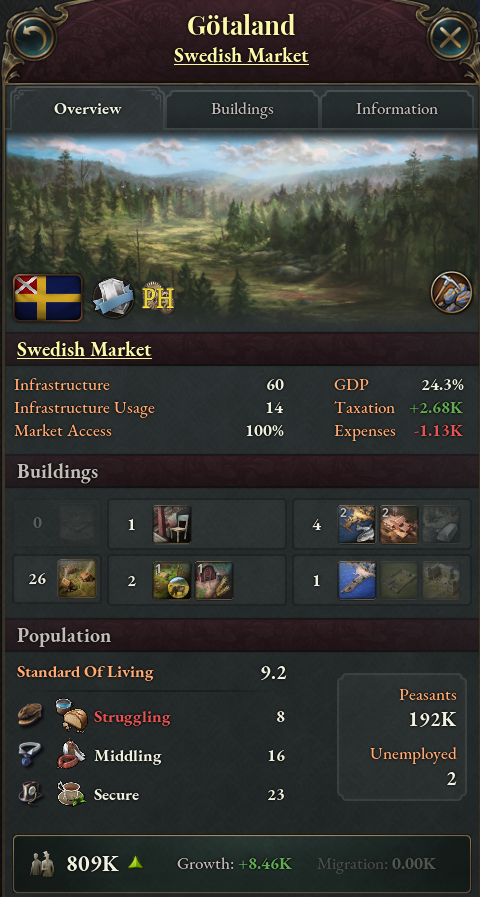
The State of Götaland in Sweden
We will return to states more in later dev diaries, but for now let’s keep talking about Buildings!
Before we start on Buildings, something that’s important to note is that Buildings are just places where Pops can work and generally do not represent a single building - a single level of Government Administration, for example, represents the necessary buildings and infrastructure to support a certain number of Bureaucrats. Buildings always need qualified pops to work in them to yield any benefit, and an empty building is just that - empty and completely useless. This holds true even for buildings like Railroads and Ports that did not need Pops to work in them in Victoria 2.
Most buildings are directly constructed, but some (like the Subsistence Buildings below) will appear automatically based on certain conditions. When Buildings are constructed, the construction uses Pop labor and goods, and the costs involved will be subject to market forces.
But onto the different building types! First out, we have Subsistence Buildings. These are a special type of highly inefficient Buildings that cannot manually be built or destroyed, but rather will appear anywhere in the world where there is Arable Land that isn’t being used for another type of building. The vast majority of the world’s population starts the game ‘working’ in subsistence buildings as Peasants, and much of the game’s industrialization process is about finding more productive employment for your Peasants.

Peasants eke out a meager living in these Subsistence Farms, contributing little to GDP and taxes per capita
Another special type of building is Urban Centers. Like Subsistence Buildings, these are automatically created rather than built, with the level of Urban Center in a State being tied to the amount of Urbanization generated by its other buildings. Urban Centers primarily employ Shopkeepers and provide a number of important local functions that we will get into at a later point.
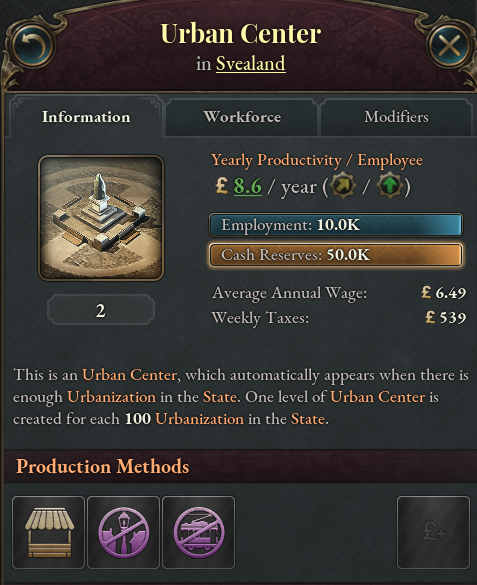
The Urban Center is where you’ll find most of your middle-class Shopkeepers
Next up we have Government Buildings. These are buildings that are fully funded by the state (ie, you!) and provide crucial civil services required for the smooth running of a Victorian nation. Examples include Government Administrations where Bureaucrats produce Bureaucracy for the administration of incorporated states and funding of Institutions, and Universities where Academics produce Innovation for technological progression.

Bureaucrats work in Government Administrations to provide Bureaucracy - the lifeblood of the government
The counterpart to Government Buildings is Private Industries. The vast majority of Buildings in Victoria 3 fall under this category, which includes a broad range of industries such as (non-subsistence!) farms, plantations, mines and factories. Unlike Government Buildings, Private Industries are not owned by the state but rather by Pops such as Capitalists and Aristocrats, who reap the profits they bring in and pay wages to the other Pops working there (usually at least - under certain economic systems the ownership of buildings may be radically different!).
Many of these buildings are limited by locally available resources such as Arable Land for agriculture and simply how much iron is available in the state for Iron Mines. Urban Buildings such as Factories however, are only limited by how many people you can cram into the state, simulating the more densely populated nature of cities. In short, there is no system of building ‘slots’ or anything like that, as we want limitations on buildings to function in a sensible and realistic way.
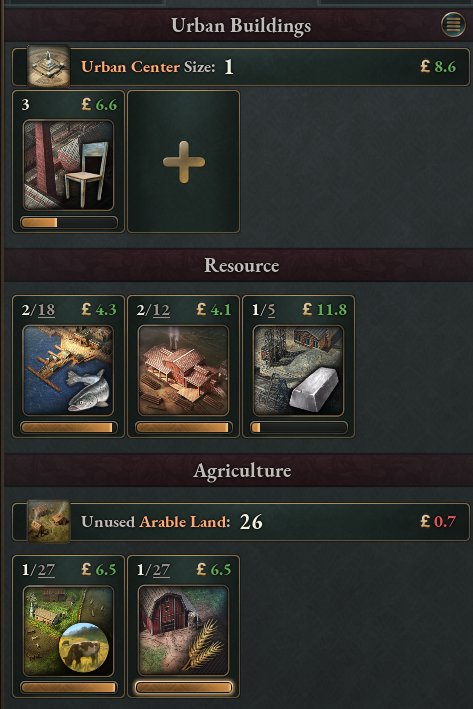
Several different types of Private Industries are shown below
Finally there are Development Buildings. These are often (but not always!) government buildings that distinguish themselves by providing vital state-level functions. A couple examples are Barracks that recruit and train soldiers from the local population and Railways that provide the Infrastructure other buildings need to bring their goods to the Market.

From left to right: Barracks, Port, Naval Bases and Railway
To finish up this dev diary I just want to mention that building up your country is meant to be more of a hands-on experience in Victoria 3, as this is absolutely core to the society-building aspect of the game and forms a major part of the game’s core loop. This naturally also means that we need to give the player the necessary tools to manage their buildings in a large empire, which may involve some form of autonomous building construction, though we haven’t yet nailed down exactly what form that would take (and whether it will involve decision making on the part of the investor class). Ultimately though, we want the player, not the AI to be the one primarily in charge of the development of their own country.
Well, there you have it. There is of course a lot in here (such as Production Methods) that will receive further explanation in the many more dev diaries we have planned, so be sure to tune in next week as I talk about Goods. See you then!
Navarro
Well-known member
Victoria 3 - Dev Diary #4 - Goods
Happy Thursday and welcome back to yet another Victoria 3 dev diary, this time on the subject of Goods! Goods are a core economic feature of Victoria 3, just as they were in previous Victoria games, and come in a wide variety of types. Also, as...
Happy Thursday and welcome back to yet another Victoria 3 dev diary, this time on the subject of Goods! Goods are a core economic feature of Victoria 3, just as they were in previous Victoria games, and come in a wide variety of types. Also, as in previous Victoria games, the manufacturing of Goods (by Pops in Buildings) is how the vast majority of the wealth in Victoria 3 is created.
Fundamentally, a unit of Goods represent a quantity of a certain type of natural resource, manufactured good or intangible service and come attached with a price tag. This price varies both in base (a single unit of Tanks is pricier than a single unit of Fabric) and in actual market value, as the prices of Goods change depending on supply and demand.

A selection of goods that are bought and sold in the British Market.
There are four broad categories of Goods: Staple Goods, Luxury Goods, Industrial Goods and Military Goods. Of these, Staple/Luxury Goods are mainly consumed by Pops, and Industrial/Military Goods are mainly consumed by buildings, but there are no hard rules here - you will find Buildings using Luxury Goods and Pops purchasing Industrial Goods when and where it makes sense for them to do so.
Staple Goods are everyday goods that Pops need to live, such as food to eat, wood to heat their homes, and clothes to wear. Staple Goods tend to be purchased in vast quantities by poor and middle class pops, with richer pops generally eschewing them for luxury variants.
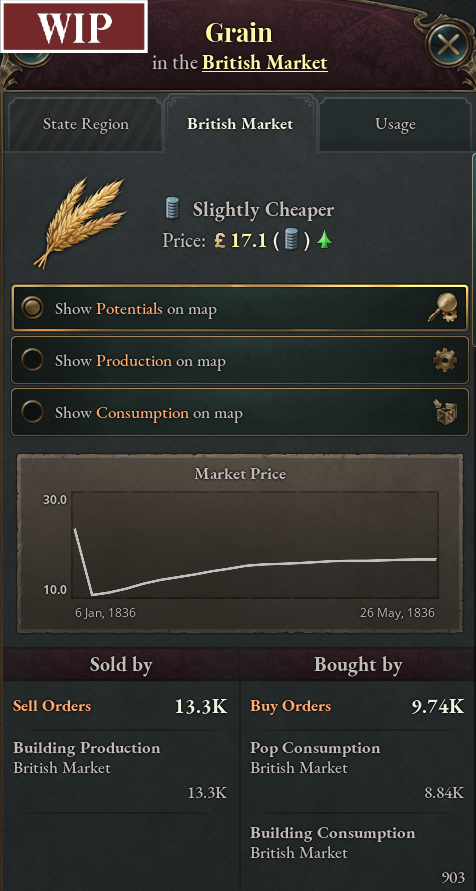
Grain - possibly the most Staple of all Staple Goods!
Luxury Goods are the things that Pops do not necessarily need but definitely want, such as fine foods, luxury drinks like Tea and Coffee, or fine clothes made from chinese silk. Luxuries tend to be more profitable to produce than Staple Goods, but depend on having a customer base with money - a poor factory worker isn’t going to be buying a whole lot of mahogany cabinets.

You can never have too many painted Ming vases, I always say.
Industrial Goods are goods such as Iron, Coal, Rubber and Lead whose main purpose is often to be converted into other, more profitable goods. Securing a steady supply of vital Industrial Goods is crucial to Industrialization and growing the GDP of your country.

Tools are essential to the operation of many industries.
Military Goods are goods such as Small Arms, Ammunition and Warships that are used by military buildings to arm and supply the armies and navies of the 19th century nations. The more technologically advanced the army or navy, the more complex (and expensive!) Military Goods they will need.
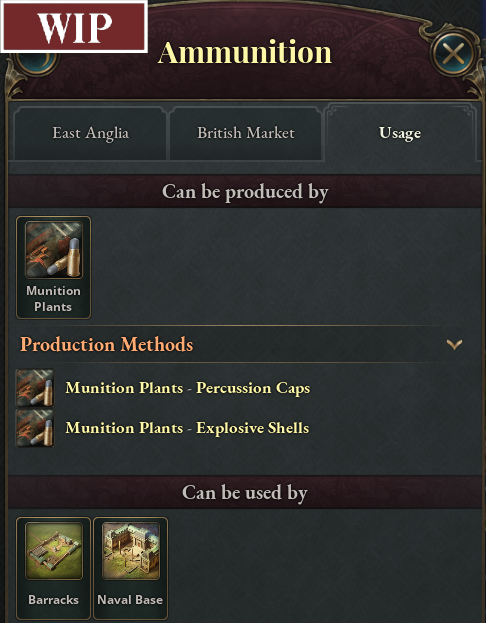
I’m told that soldiers tend to perform better if they’re given ammunition for their guns.
We’ll be returning to the topic of Goods in later dev diaries when discussing related mechanics such as Markets, Pop Needs, Goods Substitution and Cultural Obsessions... but for now, I bid you adieu for a while, as next week Mikael will provide you with a dev diary about something we’ve been teasing for some time now - Production Methods!
Navarro
Well-known member
Victoria 3 - Dev Diary #5 - Production Methods
Hello again and happy Thursday! Today we will be taking a deeper look inside Buildings to explore Production Methods. These determine the functions of the building, its inputs and outputs, and what employee types it requires to operate. Many...
Hello again and happy Thursday! Today we will be taking a deeper look inside Buildings to explore Production Methods. These determine the functions of the building, its inputs and outputs, and what employee types it requires to operate.
Many management games let you upgrade a building to increase its efficiency or expand its functionality. In these games, after the upgrade investment has been paid the impact is permanent and nearly always superior in every way to the building's previous functionality. But in Victoria 3 there are no actions without reactions, and novel innovations don't just make buildings better with no side effects. Improving industrial processes over time is to be expected, but in some cases those improvements might require goods as input that the country has scant access to, while others permit the output of a new type of end product at the expense of the old one. As a result, buildings in Victoria 3 require more flexible upgrade paths than what's afforded by permanent, linear, “no-brainer” improvements.
All buildings have several categories of Production Methods, usually between 2 and 5. Only one is active at any given time in each category. Most categories fall into one of these types:
Base: governs the general "tech level" and efficiency of the building, produces goods typical for the building type
Refining: reduces output of typical goods in favor of output of specialized or luxury goods, sometimes adding a special input
Automation: adds industrial goods as input to reduce the building's unskilled workforce requirement
Ownership: determines who owns shares in the building; typically governed by Laws
With the right technologies Food Industries can make Groceries from both Grain (Bakeries) and Fish (Canneries). They can also refine Grain and Sugar into Liquor (Distilleries). With advanced technologies Food Industries can be partially automated, drastically reducing the need for unskilled labor. Simple Food Industries are operated by Merchant Guilds (Shopkeepers), while more advanced and profitable Food Industries are owned by Capitalists who reinvest some of their dividends.
As one example, an Iron Mine's base Production Method determines if miners use only picks and shovels or if they also use some sort of engine-driven pumping mechanism. There are several different pumping technologies which also determine what fuel is used. The more advanced the pumping mechanism the more deposits can be accessed and the faster Iron can be mined, but the more Coal or Oil is used in the process. With higher tech pumps comes a requirement for more Engineers and Machinists to be on-site to control and oversee its operation. This creates more demand for qualified workers and also opens up a number of better paid positions to those Pops who meet the qualifications.
The revolution in chemical sciences of the era also enabled the use of explosives in mining, which is a secondary Production Method category used only in mines. Once Nitroglycerin is invented, it can be used in mines to generate even more minerals, at the expense of Explosives produced by the Chemical Industry but also with a higher rate of workplace accidents. By researching less volatile Dynamite, even more minerals are extracted at the expense of even more Explosives, with the additional benefit that far fewer workers will blow themselves up on the job.
Once invented, portable Steam Donkey engines can be deployed at mining sites to drastically reduce the amount of manual labor required just for hauling. This costs the building some money in the form of Coal and Engines, but reduces the amount of money they have to pay in wages. Perhaps more importantly it frees those Laborers up to do other work in other buildings if the state is running low on workers. But if wages are already very depressed it might not be a great idea to purchase expensive industrial goods just to increase the unqualified labor pool further, so this might not be a no-brainer decision for a player to make.
In most countries, simple mines are owned and operated by Merchant Guilds at game start. These are small-time purveyors of the goods produced represented by Shopkeepers. Once mines start to industrialize, Capitalists step in to take over ownership. In most cases these Capitalists will come from Shopkeepers promoted to these newly created positions, but some might come from other Pops in the state, even other Capitalists in buildings not quite as lucrative as these new mines. There are fewer Capitalists than Shopkeepers but they draw a higher wage, and more importantly they will reinvest some of their earnings into the country's expanding industry depending on how much profit their workplace is generating for them. As new ideas spread across your society you might be able to make the mining industry publicly traded instead of privately held, and later on in the game perhaps even nationalize them to be run by government bureaucrats or turn them into cooperatives where profit is split between workers.
Production Methods aren't limited to consuming and producing goods. Government Administrations employ Bureaucrats and Clerks who use Paper to produce Bureaucracy, one of the game's Capacities that let you govern more people and extend more state services to them. Railways consume Engines and a fuel such as Coal to produce both Transportation and Infrastructure, the former which is sold on the market and the latter which allows the state to support more buildings without loss of Market Access. Universities employ Academics that let the state guide research and development of new technologies and ideas. Virtually any kind of currency, modifier, or effect can be produced by Production Methods in buildings and can be applied in a variety of ways to the country, state, or even the building itself.
A basic Government Administration consumes 10 Paper and produces 50 Bureaucracy per fully-staffed level, but each additional level beyond the first adds a +2% Throughput bonus due to economy of scale. This increases both consumption of Paper and output of Bureaucracy, yielding more productivity from each of the Pops that work the building.
This of course adds a tremendous capacity for modding in new Buildings and Production Methods! Embassies that increase your Influence, but which can also be configured to consume Wine and Meat at state expense to increase the speed at which you Improve Relations? Shantytown Temples that can only be built on coastlines, that consume Fish and create jobs for pops qualifying for the Deep Ones profession, increasing state mortality but also the weekly rate of the global cthulhu_rising counter? We can't wait to see what madness you unleash!
If tweaking multiple Production Methods across several categories on every single building in the game sounds a bit complex compared to linear building upgrades - you're right! Thankfully we've built a number of tools to help with this process. Foremost among these are the Buildings panel, where you can get an overview of all buildings in your country organized by major and minor type. For example you could get an overview of all Rural buildings, or all Furniture Manufactories, or all Ports. If you have buildings of the same type in several different states, you can break it down further to view the individual building. On each level you can see how profitable the building is and adjust its Production Methods. You can even set all Production Methods for a certain building type to a specific setting all across your country with one click.
From the Buildings panel you can get a birds-eye view of all industries in your country and see at a glance how they’re doing financially. You can change Production Methods on an individual building or on all of them at once. You can even expand buildings directly from this screen if you so choose, or click on one to get an in-depth view of its balance sheet and workforce.
To minimize the requirement for mental math we have also created prediction tools that give you a breakdown of what to expect from choosing a certain Production Method, based on profitability predictions taking adjusted production and consumption into account, and summarizing which new job positions will be created and which will disappear. While it may on the surface seem obvious to just enable the Production Methods that make the buildings more profitable, keep in mind the societal effects as well - are there enough Pops in the state that qualify for the more advanced jobs this new process requires? Will the wage for these new jobs be sufficient to entice those Pops to switch professions? Will you inadvertently create a whole new class of well-to-do Machinists that may have pro-labor union sentiments? Or will the increased profits not lead to higher wages in the building because they're already competitive and fully employed, and will simply result in more dividends for the shareholders which will be funneled into increased luxury consumption? Which you choose might depend on your population’s social mobility, what politics you favor in your country (a socialist uprising may not be in your plans!) and whether you're able to supply luxuries yourself without benefiting your rival. More profitable domestic industries are never bad, but should be far from the only consideration when building your society.
Predictive tooltips will explain the anticipated impact on the building’s Balance as a result of changes in production, consumption, and wage requirements, as well as the changes in employment that could also impact the country’s politics over time. You will also be forewarned if there aren’t enough qualifying Pops to take on any new professions created, as this could limit your industry’s effectiveness.
That is all for this week. We will return to discussing more economic intricacies later, but for the next little while we'll be exploring domestic politics - starting next week when Martin will be presenting Interest Groups!




